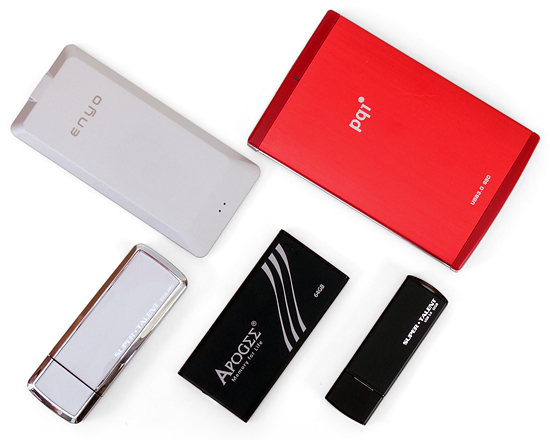Five USB 3.0 Flash Drives For Your Pocket
Do you carry around large amounts of data? Do you need to transfer it between devices in a hurry? We're examining five new USB 3.0-based portable storage solutions that might fit your needs. This time around, the focus is on maximizing portability.
In A Rush?
Imagine if you were in a real-life role similar to Daniel Zavitz in the film Enemy of the State. You’re locked in your apartment when you realize you have to transfer a huge video file quickly before leaving. Bad guys will be busting your door down any second. If your options were based on modern USB 3.0 solutions, which drive would you grab?
By now, everyone who follows technology knows the performance advantages of USB 3.0. Early USB 3.0 devices have already reached five times the performance level of the fastest previous-generation parts, and the newer standard leaves room for that performance gain to double. Yet, fitting the extra technology into ultra-portable form factors has been a huge challenge for drive manufacturers, and our roundup requests received mixed responses from the many companies that announced products last winter.
It turns out that most of those announcements were purely paper launches, as many of the devices still haven't seen the light of day. That’s a shame, because we were hoping our first large roundup would include at least a half-dozen thumb drives. Expanding today’s article to include pocket-sized 2.5”-based drives would have allowed many more companies to participate, though most of those solutions use far more fragile mechanical hard drives than the flash we have on the bench.
We finally decided that the only fair way to compare the performance of different-sized drives would be to limit this review to flash-based devices and then pick a capacity that everyone could match.
The upper capacity limit for key-sized drives appears to be 128 GB, while the performance of larger units typically falls off below that capacity level. The 128 GB capacity thus appeared to be the perfect size at which to compare today’s pocketable flash-based storage solutions, and three out of four manufacturers in today’s roundup agreed to send the appropriate drive model. The fourth manufacturer informed us that its 128 GB unit was out of stock and, knowing that this would be a portability-versus-performance article, still offered its larger-format 160 GB unit as its closest-matching product. We agreed to test it.
Two of the companies that had originally agreed to send 128 GB models instead sent 64 GB and 32 GB parts; that's why you won't find matched capacities across the products we compare today. We still include these parts to complete the roundup, and it’s obvious that those two companies feel their smaller parts are fast enough to run with the big boys. Putting aside our best-laid plans, we forged ahead to determine which of these drive best fits the portability needs of on-the-move users.
Get Tom's Hardware's best news and in-depth reviews, straight to your inbox.
-
rohitbaran ReplyThe heavy-duty gaming hardware used for today’s test is coincidental, as it was already set up on the bench for an upcoming graphics test. It includes Gigabyte’s high-flying X58A-UD9 motherboard.
Which is the mystery card? -
rohitbaran BTW, I liked Super Talent Super crypt, despite being slower than OCZ and PQI, it is the size I would be comfortable carrying in my pocket.Reply -
huron I know these technologies are more toward the "bleeding edge," but it's nice to know that manufacturers see it as enough of a market to start making products. Maybe USB 3.0 will make it mainstream relatively soon.Reply -
Would you be able to use the 128GB as a boot drive for win7 and how would they fall in price/performance between sata ssd and a VelociRaptor?Reply
-
liquidsnake718 can you play a game like crysis or even warcraft 2 well straight out of this ssd with a no cd crack?Reply -
irh_1974 reclusiveorcWould you be able to use the 128GB as a boot drive for win7 and how would they fall in price/performance between sata ssd and a VelociRaptor?I have been saying this to people for years, that one day you will have your whole PC installation on a flash drive. Just plug into a PC, boot from the flash drive and everything is there.Reply -
bCubed Too bad it will still be some time before usb 3.0 will become mainstream and even longer for extremely good drives to come outReply

